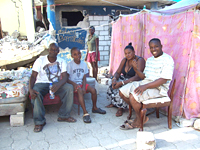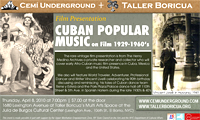|
• "Landmark Hole in the Wall" Endangered • World’s Funniest Story
• Lois in Haiti • Street Games • Cuban Music on Film
Dear Citylorists,
Please enjoy our Tours and Tales March-April e-letter!
• "Landmark Hole in the Wall" Endangered • J hate to admit it. I’m the director of City Lore with a mission to foster the City’s folk culture, but I had NEVER tasted that quintessential New York City beverage, an egg cream. In my defense, I didn’t grow up in New York, and have lived here for only 30 years, but that’s hardly an excuse. So on Saturday night I walked over to Ray’s Candy at 113 Avenue A, across the street from Tompkins Square Park, and had an egg cream. One of the reasons I never sought the fabled drink is that eggs and cream plunged into some kind of soda sounded a bit icky — so I was delighted to discover that an egg cream contains neither eggs nor cream. In fact, it’s a fountain drink consisting of syrup, milk, and selzer, associated with Brooklyn, home of its alleged inventer Louis Auster, a candy store owner.
But my first egg cream might well be my last. Ray’s Candy, this quintessential 24-hour neighborhood joint, which opened in 1974, is in danger of closing. With a menu that includes Belgian waffles, cheese fries and many varieties of egg creams, it captures a bit of funky East Village culinary decadence, threatened by gentrification. Patronized over the years by the hippies, the punks, the yuppies, the junkies, the cops, the sleep-impaired, Puerto Ricans and Ukrainians, the East Village denizens, and the neighborhod children, the site is threatened by the twin pincers of gentrification and the economic downturn. It’s a distinctive and unique neighborhood establishment that embodies and retains the character of the East Village. Ray Alvarez, who runs the shop, works the night shift from about 6:00 pm to 10:00 am, a shift that leaves him little time to take care of a number of physical problems as well.
 |
Roslyn Bresnick Perry |
Currently, Ray is trying to scrape together funds for his most pressing need, a chimney which is required by his landlord if he’s to continue selling his most lucrative product, Belgian fries. You can support Ray’s by buying a Ray’s T-shirt or hat at www.cafepress.com/SaveRays, or making a tax deductible contribution through City Lore (212-529-1955, x 301).
• World’s Funniest Story • What makes a story a classic? Is it the punchline, or the build up, or the sheer hilarity of the situation? For me, Roslyn Bresnick Perry’s story of her sister sitting on the hood of her car to keep it from getting towed on 46th street is a classic, one of my favorite stories, especially when Roz tells it—and it’s our new featured tale on City of Memory. Roz is a good friend of City Lore. She grew up in the Bronx after immigrating with her family from the small town of Wysokie Litewskie in Belarus at the age of 7. Following a career in the garment industry, she became a professional storyteller, standing before large audiences, but still telling her tales just as she might if her family was gathered around the kitchen table. She tells stories from her "shtetle" in Belarus and from the shtetle of New York.
 |
Photo by Lois Wilcken, Sedonia Moïse (fourth from left) and friends in her improvised living space on the street. |
• Lois in Haiti • Lois, our Accounts Manager and director of the Haitian La Troupe Makandal, is just back from Haiti where she traveled to bring tents and supplies to the families and friends of her Brooklyn-based group. From Haiti, she wrote:
As night falls on Ruelle Gabelis, a street that winds westward from the back of the Grand Cemetery of Port-au-Prince, Sedonia Moïse prepares beds for herself, her sister, her husband, and her grandson. She clears sleeping space at the feet of the beds for three neighbors, one of them a young man named Pinocchio. In good times in Haiti, the act of giving a neighbor a spot on your floor to sleep is normal. But this floor is the asphalt of Ruelle Gabelis, and the bedtime preparations take place against the backdrop of ruins. Like the crypts on the other side of the wall up the street, the homes that trembled and collapsed on January 12 entomb the luckless more than two months after the catastrophe. At night you almost expect to see ghosts rising from the rubble.
Back in our office, she talked first hand of some of the surreal, and sometimes ironic, events. She told of the man who, when the earthquake struck, was inscribing a veve drawing on the sidewalk in powder. (The veve signifies the doorway between our world and the world of the Gods, the "invisibles.") He literally thought the ground opened into that other world. Lois also described a building in Port-au-Prince which looked strange to her until she realized that it was a three story building that was now a two story building. The structure pancaked, killing everyone on the first floor, many of them still entombed beneath the ground. Residents of the second and third floors walked away unscathed. She was touched by the spirit in the tent cities, where women have opened beauty parlors, and one man even opened a tent where you could charge your cell phone and watch a movie. Lois continued,
The contrast between the destruction that scars Port-au-Prince and the optimism and morale of Haitian people may astonish outsiders. But Haitian tradition takes the dualism for granted and embodies it in the spirit Gede (Geh-deh), a master of death and resurrection. Thus, Sedonia Moïse goes to bed among the wreckage of her neighborhood, closes her eyes, and envisions a new Haiti.
 |
Photo by Martha Cooper |
• Street Games • When my wife, Amanda and I first moved to the City in 1981, we documented the importance New Yorkers attribute to their street games in the book City Play. Many of the people we spoke to before and since talked to us about what it meant to be a "three or four sewer man" in stickball. Among them was Mick Green who started the site streetplay.com. "Word has it that Willie Mays was a 4-sewer man. We’ve had arguments about this, cause it just doesn’t seem possible. In our neighborhood each sewer (manhole cover) is a block. 4 sewers=1/5 of a mile - that’s about 1,000 feet!" This passion for street games is captured in a forthcoming documentary, directed by Matt Levy, starring a celebrity cast including Regis Philbin, Ray Romano (I Love Raymond), and Curtis Sliwa, along with some regular folks like myself. Catch the trailer, with some actual footage of Willy Mays playing stickball here. In the trailer, someone claims Mays hit that spaldeen five miles!
 |
Photo by Amy Touchette |
• Cuban Music on Film • On Thursday April 8th, at 7:00 pm at Taller Boricua's Multi Arts Space at the Julia de Burgos Cultural Center (1680 Lexington Avenue), catch a special program, Cuban Popular Music on Film 1929-1960’s. The rare vintage film presentation is from The Henry Medina Archives, work of a private researcher and collector who will cover early Afro-Cuban music on film in Cuba, Mexico and the United States. Also featured will be world traveler, adventurer, professional dancer and writer, Vincent Livelli celebrating his 90th birthday, discussing and reminiscing his tales of Cuban dance team Rene y Estela and the Park Plaza/Palace dance hall off 110th Street & 5th Ave. in Spanish Harlem during the late 1930’s & 40’s. Some of the highlights will cover the early African diaspora traditions in Cuban music, early films of Cuban dance, La Sonora Mantacera, Miguelito Valdes, Beny Moré, rumba dancer Ninon Sevilla, the rumba of Silvestre Mendez, a tribute to Arsenio Rodriguez and many others. For more info email the Archives at hmj47@hotmail.com or hmj8s@yahoo.com. If you haven’t seen it yet, City Lore’s documentary, From Mambo to Hip Hop, is available on DVD from City Lore's Culture Catalog online store or call us at 212-529-1955, x 305.
Please forward this email to your friends and encourage them to join the City Lore's email list!
Enjoy the City!

City of Memory is sponsored by City Lore and Local Projects. It was funded by The Rockefeller Foundation and the National Endowment for the Arts.
City Lore is part of a cultural coalition called CATCH, to promote the City’s cultural heritage. Check out the web sites of our wonderful partners, the Center for Traditional Music and Dance, the Latino Children’s Theater, SEA, and the World Music Institute. |
